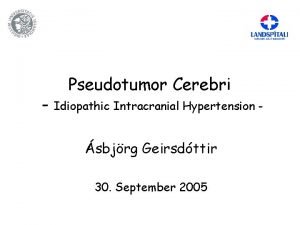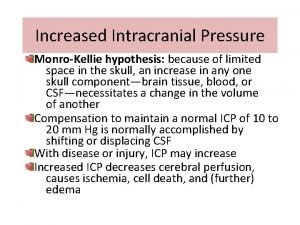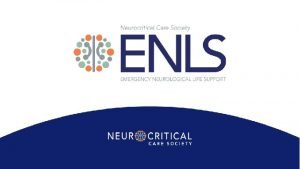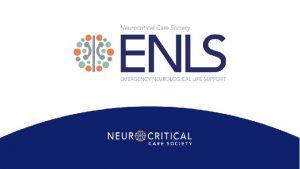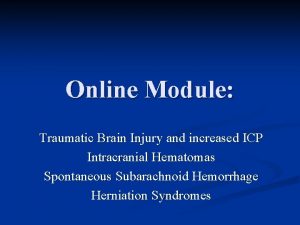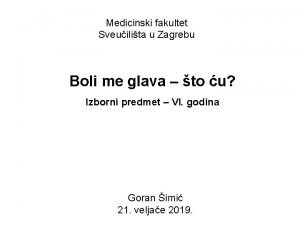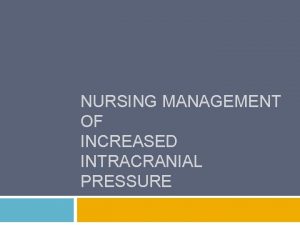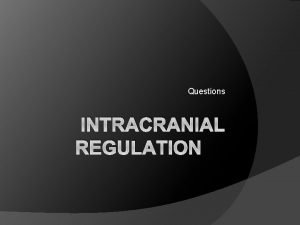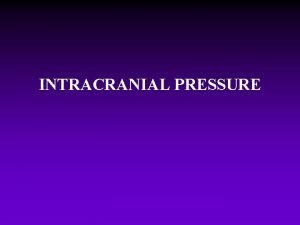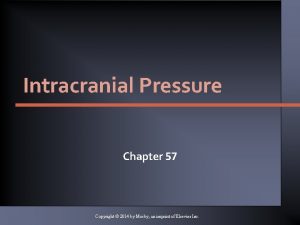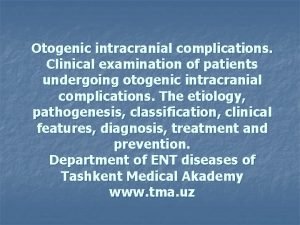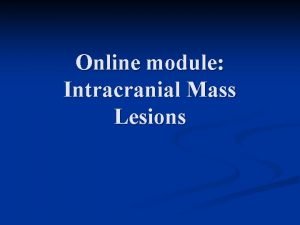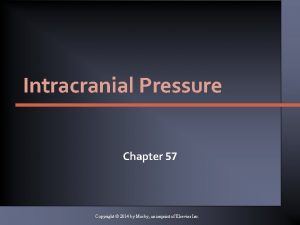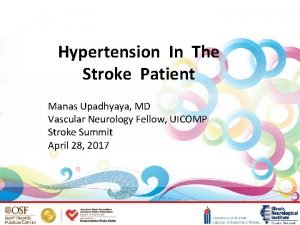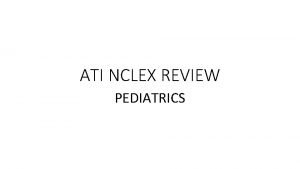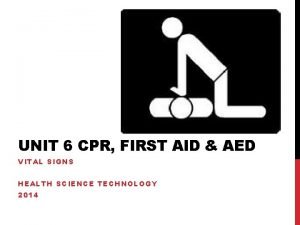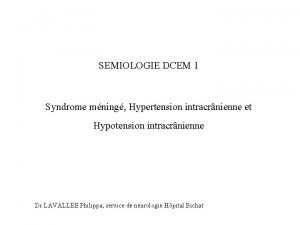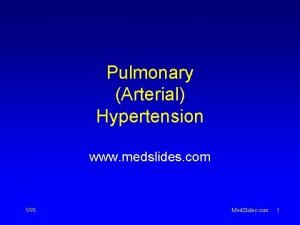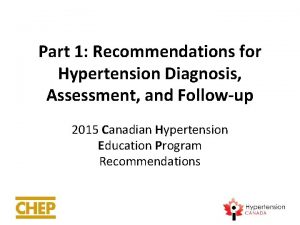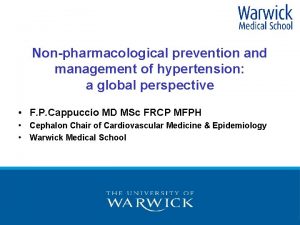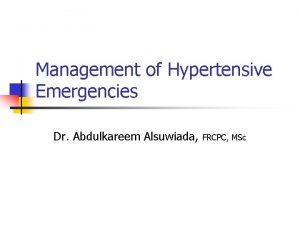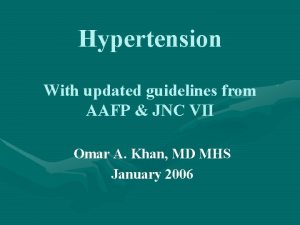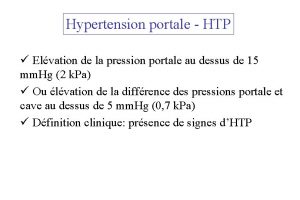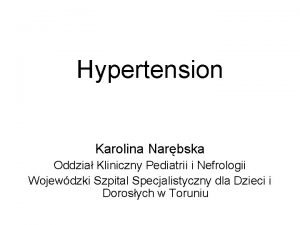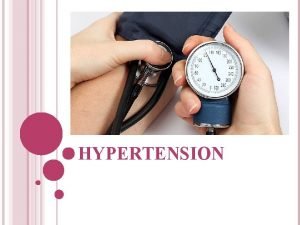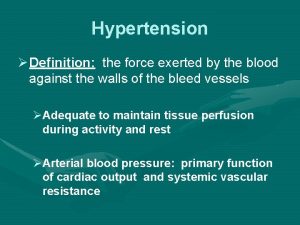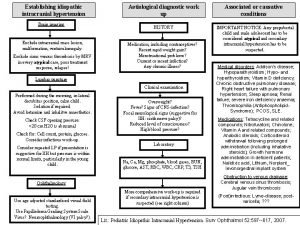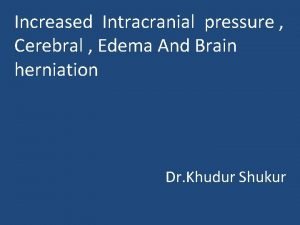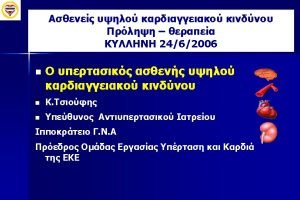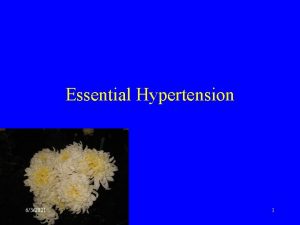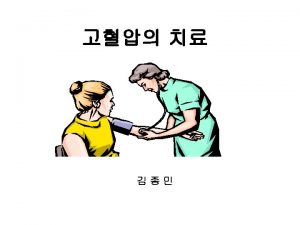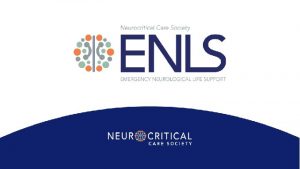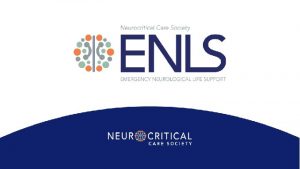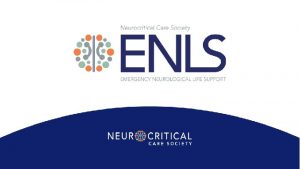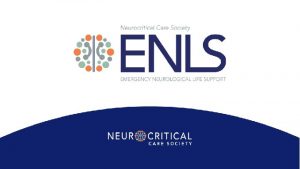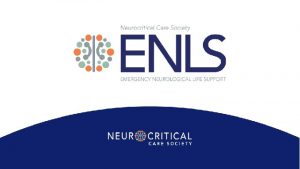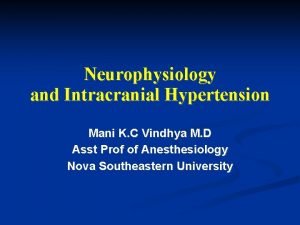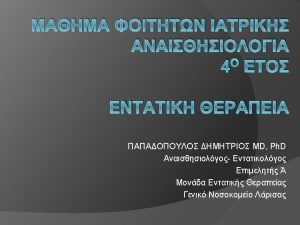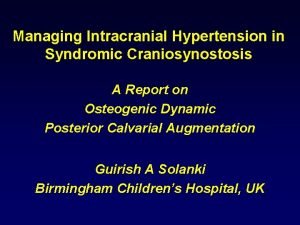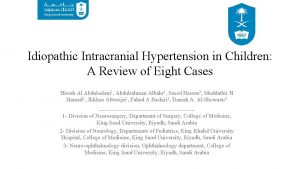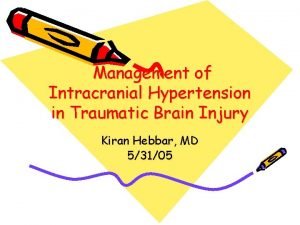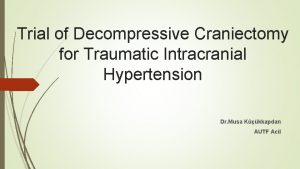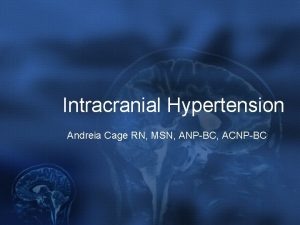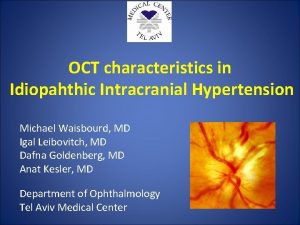ENLS Version 4 0 Intracranial Hypertension And Herniation





































- Slides: 37


ENLS Version 4. 0 Intracranial Hypertension And Herniation Content: Jonathan J. Ratcliff, MD, MPH; Christopher Morrison, Pharm. D, BCCCP, FNCS; Deborah S. Tran, DNP, RN, CNRN, SCRN, NE-BC; Christopher M. Ruzas, MD Slides: Krista Garner, DNP, and Vishal N. Patel, MD

Presenter: Your name Your institution Conflicts: No conflicts

Editors’ Note: Global Considerations The intent of the editors, authors, and reviewers of this ENLS topic was not to address all the variations in international practice for the different diseases. We have discussed major practice variances (e. g. , the availability of diagnostic testing, or the type of medications used) and encourage learners to use the ENLS algorithms as a framework on which any relevant local practice guidelines can be incorporated.

Intracranial Hypertension and Herniation

Intracranial Hypertension and Herniation Learning Objectives • Recognize the signs and symptoms of cerebral herniation and elevated intracranial pressure • Apply a staged approach to the reversal of herniation and/or reduction in intracranial pressure

Intracranial Compartments

Increased ICP or Herniation ICP pressure & volume curve • Compliance – (∆V/∆P) • High compliance – (a) • Low compliance – (b) • Elastance - ∆P/∆V Elevated ICP: ICP > 22 mm. Hg sustained for > 5 min Cerebral PERFUSION pressure = MAP - ICP

Etiologies of the Brain Code Extra-axial Process Focal Brain Process Diffuse Brain Process Epidural hemorrhage Brain tumor (primary, metastatic) Traumatic brain injury Subdural hemorrhage Ischemic stroke Aneurysmal SAH Subdural empyema Primary intracerebral hemorrhage Infectious meningitides & encephalitides Extra-axial brain tumor Traumatic brain Injury Non-infectious neuroinflammatory disorders Pneumocephalus Hydrocephalus Hepatic encephalopathy Brain abscess Toxic-metabolic encephalopathies Non-infectious neuroinflammatory disorders

Examples of Acute Risk for Herniation

Increased ICP or Herniation syndromes • Subfalcine (cingulate) • Uncal • Central (tentorial) • Tonsillar (↓ cerebellum) • Upwards (↑ cerebellum)

Herniation Syndromes

Clinical Signs and Symptoms of Increased ICP or Herniation “EARLY” “LATE” Headache Changes in level of consciousness or ↓ GCS or FOUR Score ≥ 2 points Irritability Ipsilesional change in pupillary size, shape and light-responsiveness Vomiting Contralesional hemiparesis (new or worsening) Photophobia, nystagmus, diploplia Contralesional change in pupillary size and ipsilesional hemiparesis (Kernohan’s phenomenon) Lethargy Cushing’s triad: ↑ SBP (widened pulse pressure), bradycardia, irregular respirations Seizure

Case • • • 64 -year-old male auto vs. pedestrian accident GCS 7 in the ED No focal neurological deficits Temp 35. 7⁰C, HR 95 bpm BP 115/62 mm. Hg, SP 02 85%

Case • Our patient is intubated, given his low GCS and hypoxia. • His CT brain shows bifrontal contusions and subdural blood • Given the CT findings and his low GCS, an EVD is placed. • Initial ICP is 29.

ICP Monitoring

ICP Waveform ICP waveform • P 1 - (Percussion wave) thought to reflect arterial pulsation • P 2 - (Tidal wave) thought to reflect degree of intracranial compliance • P 3 - (Dichrotic wave) thought to reflect aortic valve closure ICP wave form analysis • When P 2 > P 1, suggests that brain has poor compliance / at risk for impending herniation & brain code

Standard Measures to Treat ↑ ICP Obtain Non-contrast Head CT q Assess ABCs q Head of bed > 30 degrees q Minimize noxious stimuli q Neck midline q Analgesia / sedation q Steroids in select conditions q Isotonic or hyperosmotic fluids q Avoid & correct hyponatremia q Target normothermia (36 -37. 4º C )

Escalating Measures to Treat ↑ ICP Tier 1 Measures if Tier 0 / Standard Measures Fail q Hyperosmolar therapy q Temporary Hyperventilation to a Pa. CO 2 of 30 -35 mm. HG q CSF Drainage q Consider Surgical Decompression

Case • After several mannitol and hypertonic saline boluses and allowing his EVD to drain CSF several times, his ICP lowers to 27 mm. Hg. • He is mildly hyperventilated to a PCO 2 of 33 mm. Hg, but his ICP remains 27 mm. Hg.

Escalating Measures to Treat ↑ ICP Tier 2 Measures if Tier 1 Measures Unsuccessful q Hyperosmolar therapy for higher Na Goals q Optimize sedation & analgesia q Rescue decompressive surgery should be considered as a life saving intervention

Surgical Decompression • For those failing medical management: § Review decompressive surgical options with neurosurgery § Evacuation of mass lesion or decompression craniectomy • If the patient is ineligible for surgery or too unstable to obtain brain imaging, proceed to Tier 3 treatment

Case • The patient is started on 3% Na. Cl, and his serum sodium is now 155 m. Eq/L. • Propofol is started for sedation. • ICPs remain 26 mm. Hg. • Repeat CT head does not show any new hemorrhage. • Neurosurgery does not feel he is a surgical candidate.

Escalating Measures to Treat ↑ ICP Tier 3 Measures if Tier 2 Measures Unsuccessful & Surgery Decompression not an option q Sedation titrated to ICP goal or burst suppression on C-EEG q Hyperventilation to achieve mild to moderate hypocapnia (Pa. CO 2 25 -35 mm. Hg) q Moderate hypothermia (target core temperature 32 -34ºC) Consider Revising Goals

Case • The patient is loaded with pentobarbital. • His EEG shows burst suppression in the 8 -10 second range. • ICPs lower to 16 mm. Hg. • He is maintained on pentobarbital for 48 hrs and then is weaned off. • ICPs remain 10 -15 mm. Hg, and the EVD is eventually removed.

Consider Additional Neuromonitoring • Brain tissue oxygenation • Cerebral microdialysis • Transcranial doppler-derived CBF

Pediatric Considerations • Management of intracranial hypertension should be analogous to adults. • Open fontanel does not mean infants cannot develop ↑ ICP and herniation. • Infants and small children: CPP goal > 40 mm. Hg • Older children and adolescents: CPP goal > 50 mm. Hg • Mannitol and hypertonic saline may be used for sustained ICP > 20 mm. Hg or signs of brain herniation. • Hypertonic saline is preferred over mannitol in pediatric patients.

Pediatric Considerations Special circumstances: • ~0. 5 -1% children with diabetic ketoacidosis (DKA) develop severe cerebral edema. • Volume resuscitation should be in small aliquots targeting hemodynamic factors rather than rapid correction of total volume deficit.

Communication Checklist EMS / Prehospital Notification q Identification q Injury mechanism (i. e. , stroke, trauma, seizure) q Relevant known medical history q Vitals signs (including glucose) q Neurological assessment (GCS, NIHSS, pupils) q Interventions

Communication Checklist Transfer of Care q Patient identifiers q Injury mechanism and relevant known history q Clinical neurologic exam q Treatments for ICP and response q Anticipated next steps

Question #1 • • • A 60 -year-old man is admitted to the neuro ICU for intracerebral hemorrhage and intracranial hypertension. The patient's weight is 75 kg. Labs indicate normal renal function. ICP monitor reveals an ICP of 25 -30 mm. Hg for 10 minutes. You decide to administer mannitol. What is the correct dose of mannitol for this patient? A. 25 g B. 75 g C. 150 g D. 200 g E. 1000 g

Question #1 • • • A 60 -year-old man is admitted to the neuro ICU for intracerebral hemorrhage and intracranial hypertension. The patient's weight is 75 kg. Labs indicate normal renal function. ICP monitor reveals an ICP of 25 -30 mm. Hg for 10 minutes. You decide to administer mannitol. What is the correct dose of mannitol for this patient? A. 25 g B. 75 g C. 150 g D. 200 g E. 1000 g

Question #2 Intracranial hypertension is defined as a sustained elevation (> 5 minutes) of ICP to above what value? A. B. C. D. E. 18 mm. HG 22 mm. HG 25 mm. HG 30 mm. HG 40 mm. HG

Question #2 Intracranial hypertension is defined as a sustained elevation (> 5 minutes) of ICP to above what value? A. B. C. D. E. 18 mm. HG 22 mm. HG 25 mm. HG 30 mm. HG 40 mm. HG

Question #3 An increase in the second component of the invasive ICP curve (P 2=cerebral venous return) is a warning sign for: (Image on left reflects normal ICP waveform) A. B. C. D. E. Seizures Relaxation of the brain CSF over drainage Poor cerebral compliance Cerebral infection

Question #3 An increase in the second component of the invasive ICP curve (P 2=cerebral venous return) is a warning sign for: (Image on left reflects normal ICP waveform) A. B. C. D. E. Seizures Relaxation of the brain CSF over drainage Poor cerebral compliance Cerebral infection

Questions?
 Intracranial hypertension
Intracranial hypertension Decorticate posturing
Decorticate posturing Enls discount code
Enls discount code Enls neurocritical care
Enls neurocritical care Tonsillar herniation
Tonsillar herniation Kernohan's notch
Kernohan's notch Decorticate red nucleus
Decorticate red nucleus Glasgow coma scale
Glasgow coma scale Nursing interventions for stroke patients
Nursing interventions for stroke patients Uncal herniation
Uncal herniation Nursing management of increased intracranial pressure
Nursing management of increased intracranial pressure Intracranial regulation nursing
Intracranial regulation nursing Decerebrate posturing
Decerebrate posturing Mui.ac
Mui.ac Patient condition
Patient condition Intracranial teratoma
Intracranial teratoma Adhesive arachnoiditis
Adhesive arachnoiditis Intracranial mass
Intracranial mass Cushing reflex
Cushing reflex Intracranial pressure
Intracranial pressure Intracranial hypotension radiopedia
Intracranial hypotension radiopedia Increased intracranial pressure ati
Increased intracranial pressure ati Signs of portal hypertension
Signs of portal hypertension Hypertension artérielle
Hypertension artérielle 6 vital signs first aid
6 vital signs first aid Hypertension
Hypertension Jnc 7 hypertension
Jnc 7 hypertension Pachyméninges
Pachyméninges Med
Med Hypertension
Hypertension Diagnosis hypertension
Diagnosis hypertension Non pharmacological management of hypertension
Non pharmacological management of hypertension Htn emergency vs urgency
Htn emergency vs urgency Jnc 7 hypertension
Jnc 7 hypertension Signe de cruveilhier baumgarten
Signe de cruveilhier baumgarten Non pharmacological management of hypertension
Non pharmacological management of hypertension Rules of halves in hypertension
Rules of halves in hypertension Systemic vascular resistance
Systemic vascular resistance
